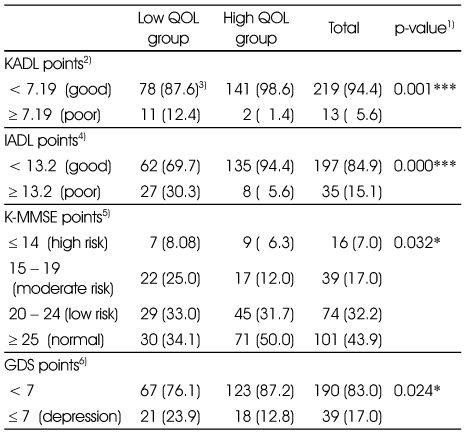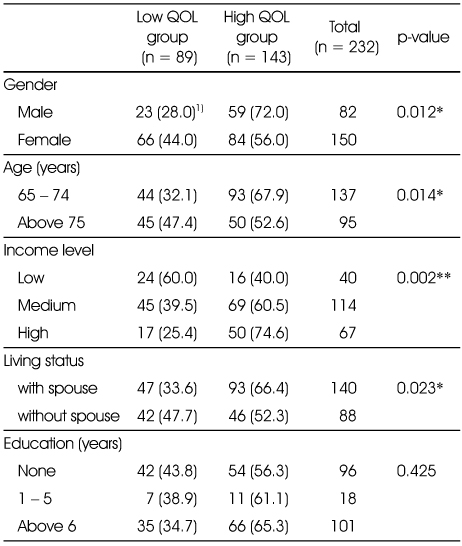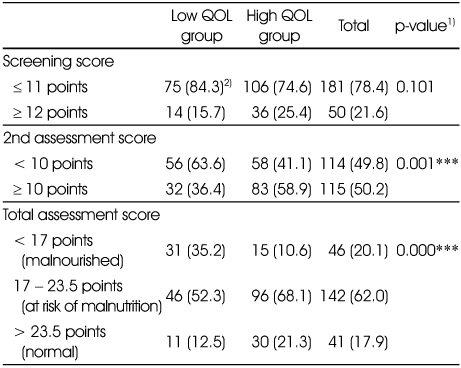Articles
- Page Path
- HOME > Korean J Community Nutr > Volume 17(6); 2012 > Article
-
Original Article
- Health-Related Factors Influencing the Quality of Life of Rural Elderly Subjects: Activities of Daily Living, Cognitive Functions, Prevalence of Chronic Diseases and Nutritional Assessment
- Mee Sook Lee
-
Korean Journal of Community Nutrition 2012;17(6):772-781.
DOI: https://doi.org/10.5720/kjcn.2012.17.6.772
Published online: December 31, 2012
Department of Food and Nutrition, Hannam University, Daejeon, Korea.
- Corresponding author: Mee Sook Lee, Department of Food and Nutrition, Hannam University, #461-6 Jeonmin-dong, Yuseong-gu, Daejeon 305-811, Korea. Tel: (042) 629-8794, Fax: (042) 629-8789, meesook@hnu.kr
Copyright © 2012 The Korean Society of Community Nutrition
- 867 Views
- 2 Download
- 16 Crossref
Abstract
- In order to supply the reference data to define the quality of life of the rural agricultural elderly population in the simplified steps, the data were collected by personal visits to 232 elder people over 65 (89 males and 143 females) in Sunchang area. The survey was conducted with written questionnaires concerning the quality of life, health-related habits, basic physical functions and cognitive behavior. The prevalence of the degenerative diseases were assessed by anthropometric and biochemical determinations. The averaged overall quality of life represented by EQ-5D index with Nam's model was calculated to be 0.865 ± 0.1509, and the percentages of people below the average were 38% (low QOL group) and 62% (high QOL group) were found to be the above the average. Generally, the subjects with male gender, higher educational background, higher self-rated health status, higher social activities were belonged to the high QOL group. The high QOL group had higher scores of daily living activities KADL and IADL, and lower risks in cognitive functions K-MMSE and depression scale GDS. There was no statistically significant correlation between biochemical indexes of blood and cognitive function and EQ-5D scores when the results were adjusted for age and gender. There were significant differences in nutritional assessment determined by the MNA between the high and low QOL groups. The low QOL group showed inferior nutritional status. The rapidly measurable factors of the quality of life of rural elderly were turned out to be physical activity scores and the simplified nutritional status measurement.
- 1. Acree LS, Longfors J, Fjeldstad AS, Fjeldstad C, Schank B, Nickel KJ, Montgomery PS, Gardner AW. Physical activity is related to quality of life in older adults. Health Qual Life Outcomes. 2006; 4: 37.ArticlePubMedPMCPDF
- 2. Ahn MH, Kim KU. A study of quality of life and depression for the elderly in senior welfare center. J Korea Acad Ind Coop Soc. 2012; 13(8): 3544-3551.Article
- 3. Bize R, Johnson JA, Plotnikoff RC. Physical activity level and health-related quality of life in the general adult population: A systematic review. Prev Med. 2007; 45: 401-415.ArticlePubMed
- 4. Brown JE. In: Brown JE, editor. Mini nutritional assessment. Nutrition through the life cycle. 2011; 4th ed. Wadsworth: 466.
- 5. Choe JS, Kwon SO, Paik HY. Health-related quality of life by socioeconomic factors and health-related behaviors of the elderly in rural area. Korean J Rural Med. 2004; 29(1): 29-41.Article
- 6. Chung JY, Lee MY, Kim MJ. A study on the prevalence of chronic disease, health-related habits and nutrient intakes according to the quality of life in Korean adults. Korean J Community Nutr. 2010; 15(4): 445-459.
- 7. Han MA, Ryu SY, Park J, Kang MG, Park JK, Kim KS. Health-related quality of life assessment by the EuroQol-5D in some rural adults. J Prev Med Public Health. 2008; 41(3): 173-180.ArticlePubMed
- 8. Hagstrom B, Mattsson B, Wimo A, Gunnarsson RK. More illness and less disease? A 20-year perspective on chronic disease and medication. Scand J Public Health. 2006; 34: 584-588.ArticlePubMedPDF
- 9. Jang YR, Chiriboga DA, Kim GY. Acculturation and manifestation of depressive symptoms among Korean American older adults. Korean J Res Gerontol. 2006; 15(1): 51-73.Article
- 10. Janssen MF, Birnie E, Haagsma JA, Bonsel GJ. Comparing the standard EQ-5D three-level system with a five-level version. Value Health. 2008; 11(2): 275-284.ArticlePubMed
- 11. Jhoo JH, Kim KW, Lee DY, Youn JC, Lee TJ, Choo IH, Ko HJ, Seo EH, Woo JI. Comparison of the performance in two different Korean versions of Mini-Mental State Examination: MMSE-KC and K-MMSE. J Korean Neuropsychiatr Assoc. 2005; 44(1): 98-104.
- 12. Kang E, Shin H, Park H, Jo M, Kim N. A valuation of health status using EQ-5D. Korean J Health Econ Policy. 2006; 12(2): 19-43.
- 13. Kim JH, Koo BK, Kim KJ, Baek JW, Lee YK, Lee SK, Lee HS. Characteristics of eating behaviors of the long-lived elderly people in Kyungpook Sung-Ju. Korean J Community Nutr. 1999; 4(2): 219-230.
- 14. Kim JY, Lee SG, Lee SK. The relationship between health behaviors, health status, activities of daily living and health-related quality of life in the elderly. J Korean Gerontol Soc. 2010; 30(2): 471-484.
- 15. Kim SY, Yun JE, Kimm H, Jee SH. The relation of physical activity by the IPAQ to health-related quality of life - Korea National Health and Nutrition Examination Survey (KHANES) IV 2007-2008. J Korean Soc Health Educ Promot. 2011; 28(2): 15-25.
- 16. Kim WK. Subjective and objective social support in the association between physical disability and depression in older adults. Korean J Res Gerontol. 2001; 10(1): 55-74.
- 17. Kwon YC, Park JH. Korean Version of Mini-Mental State Examination (MMSE-K) Part I: Development of the Test for the Elderly. J Korean Neuropsychiatr Assoc. 1989; 28(1): 125-135.
- 18. Lee MS. Nutritional status of the nonagenarian population in longevity belt in Korea. Korean J Community Nutr. 2005; 10(3): 290-302.
- 19. Lee JW, Lee MS, Kim JH, Son SM, Lee BS. Nutritional assessment. 2012; Paju: Kyomunsa; 169-238.
- 20. Lee SI. Validity and reliability evaluation for EQ-5D in Korea. 2012; cited 2012 Nov. 21. Korea Centers for Disease Control & Prevention (KCDC); Available from http://www.cdc.go.kr/CDC/contents/CdcKrContentLink.jsp.
- 21. Lee YH, Choi JS, Rhee JA, Ryu SY, Shin Mh, Kim JH. A study on the application of the Korean valuation weights for EuroQoL-5 dimension. J Korean Soc Health Educ Promot. 2009; 26(1): 1-13.
- 22. McNaughton SA, Crawford D, Ball K, Salmon J. Understanding determinants of nutrition, physical activity and quality of life among older adults: the Wellbeing, Eating and Exercise for a Long Life (WELL) study. Health Qual Life Outcomes. 2012; 10: 109.ArticlePubMedPMC
- 23. Ministry of Health & Welfare. In-depth analyses of the third Korea National Health and Nutrition Examination Survey (KHANES III) 2005: The health interview and health behavior survey part. 2007; cited 2012 Nov. 21. Available from http://knhanes.cdc.go.kr.
- 24. Ministry of Health & Welfare. The Korea National Health and Nutrition Examination Survey (KHANES IV) 2007: The health interview and health behavior survey part. 2008; cited 2012 Nov. 21. Seoul: Available from http://knhanes.cdc.go.kr.
- 25. Nam HS, Kim KY, Kwon IS, Koh KW. EQ-5D Korean valuation study using time trade-off method. 2007; cited 2012 Nov. 21. Seoul: Korea Centers for Disease Control and Prevention (KCDC); Available from http://www.cdc.go.kr/CDC/contents/CdcKrContentLink.jsp.
- 26. Park MJ. The cognition, balance, and quality of life in the elderly. J Korean Biol Nurs Sci. 2011; 13(2): 185-192.
- 27. Phelan EA, Anderson LA, LaCroix AZ, Larson EB. Older adults' views of "successful aging"- how do they compare with researchers' definitions? J Am Geriatr Soc. 2004; 52: 211-216.ArticlePubMed
- 28. Schünemann HJ, Sperati F, Barba M, Santesso N, Melegari C, Akl EA, Guyatt G, Muti P. An instrument to assess quality of life in relation to nutrition: item generation, item reduction and initial validation. Health Qual Life Outcomes. 2010; 8: 26.ArticlePubMedPMC
- 29. Seong SS, Choi CB, Sung YK, Park YW, Lee HS, Uhm WS, Kim TW, Jun JB, Yoo DH, Lee OY, Bae SC. Health-Related Quality of Life using EQ-5D in Koreans. J Korean Rheum Assoc. 2004; 11(3): 254-262.
- 30. So H, Kim H, Ju K. Prediction model of quality of life in elderly based ICF model. J Korean Acad Nurs. 2011; 41(4): 481-490.ArticlePubMed
- 31. Sohn S. A comparison study on the life quality of the elderly and its affecting factors between rural and urban areas. J Korean Gerontol Soc. 2006; 26(3): 601-615.
- 32. Sohn S. Factors related to the health related quality of life in elderly women. Korean J Women Health Nurs. 2009; 15(2): 99-107.Article
- 33. Sohn A, Hong IO, Kim J. Health-related quality of life assessment by health behavior and BMI among Seoul citizens. Korean Public Health Res. 2010; 36(2): 19-25.
- 34. Spilker B, Revicki DA. In: Spilker B, editor. Taxonomy of quality of life. Quality of life and phamacoeconomics in clinical trials. 1996; 2nd ed. Philadelphia: Lippincott-Raven Publisher; 25-31.
- 35. Statistics Korea. Population projections 2010-2060. 2012a; cited 2012 Nov. 21. Available from http://kosis.kr.
- 36. Statistics Korea. 2010 Life tables for Korea. 2012b; cited 2012 Nov. 21. Available from http://kosis.kr.
- 37. Statistics Korea. 2010 Census: Population and housing. 2012c; cited 2012 Nov. 21. Available from http://kosis.kr.
- 38. The EuroQoL group. EuroQoL - a new facility for the measurement of health-related quality of life. Health Policy. 1990; 16(3): 199-208.ArticlePubMed
- 39. Ware JE, Sherbourne CD. The MOS 36-item short-form health survey (SF-36). I. Conceptual framework and item selection. Med Care. 1992; 30: 473-483.PubMed
- 40. WHOQOL Group. The World Health Organization Quality of Life Assessment (WHOQOL): Position paper from the World Health Organization. Soc Sci Med. 1995; 41(10): 1403-1409.ArticlePubMed
- 41. Won CW, Yang KY, Rho YG, Kim SY, Lee EJ, Yoon JL. the development of Korean activities of daily living (K-ADL) and Korean instrumental activities of daily living (K-IADL) scale. J Korean Geriatr Soc. 2002; 6(2): 107-120.
- 42. Yun JH, Kang JM, Kim KS, Kim SH, Kim TH, Park YW, Sung YK, Sohn JH, Song BJ, Uhm WS, Yoon HJ, Lee OY, Lee JH, Lee CB, Lee CH, Jung WT, Choe JY, Choi HS, Han DS, Bae SC. Health-Related Quality of Life in Korean Patients with Chronic Diseases. J Korean Rheum Assoc. 2004; 11(3): 263-274.
REFERENCES


1) SBP: systolic blood pressure, DBP: diastolic blood pressure, TC: total cholesterol, TG: triglyceride, Glu: fasting blood glucose, BMI: body mass index, KADL: Katz-activities of daily living, IADL: instrumental activities of daily living, GDS: geriatric depression scale, KMMSE: Korea mini-mental state examination, MNA: mini-nutritional assessment
2) Pearson's correlation coefficient
***: p < 0.001
Figure & Data
REFERENCES
Citations

- Effect of home-based exercise program on balance, activities of daily living, depression and quality of life in elderly with chronic diseases
Il Yong Jang, Yo Han Song, Jae Woon Kim, Young Sung Moon
The Journal of Korean Academy of Physical Therapy Science.2024; 31(2): 41. CrossRef - Study on the relationship between dietary habits and the quality of life of some high school students in Seoul based on the nutrition quotient for adolescents (NQ-A)
Ho-Jung Kim, Jung-Sug Lee, Yookyung Kim
Journal of Nutrition and Health.2024; 57(3): 320. CrossRef - Factors associated with malnutrition in demented and non-demented elderly residing in the community of Korea: a cross-sectional descriptive and analytical study
Jinhee Kwon, Jung Hee Kim, Hyeonjin Jeong, Jung Suk Lee
Korean Journal of Community Nutrition.2024; 29(5): 359. CrossRef - Effects of Cognicise-Neurofeedback on Health Locus of Control, Depression, and Quantitative Electroencephalography Alpha Asymmetry in Elderly Women
Heewook Weon, Jieun Yoo, Jumhwa Yu, Miso Park, Haekyoung Son
Brain Sciences.2021; 11(7): 899. CrossRef - Study on the Nutrient Intake and Dietary Quality of Elderly Residents on Various Meal Types in Long-Term Care Facility
Hee-Sook Lim, Eun Bi Oh, Yoo Kyoung Park, Hae-Yun Chung
Journal of the East Asian Society of Dietary Life.2020; 30(2): 172. CrossRef - Evaluation of the dietary quality and nutritional status of elderly people using the Nutrition Quotient for Elderly (NQ-E) in Seoul
Sun-Wook Ham, Kyung-Hee Kim
Journal of Nutrition and Health.2020; 53(1): 68. CrossRef - Effect of Geographic Area on Dietary Quality across Different Age Groups in Korea
Hyun Ja Kim, Kirang Kim
Korean Journal of Community Nutrition.2019; 24(6): 453. CrossRef - Health Related Quality of Life Assessment by the EQ-5D of Agriculture, Forestry, and Fishery Workers
Woun-Jong Choi, Kyeong-Su Kim, Hyeon-Gyeong Lee, Hyo-Cher Kim, Hye-seon Chae, Kyung-Suk Lee, Dong-Phil Choi
The Korean Journal of Community Living Science.2018; 29(3): 399. CrossRef - Association between masticatory ability, oral health-related quality of life and cognitive function in the elderly population using structural equation modeling
Hae-Eun Shin, Ic-Jun Chang, Min-Jeong Cho, Keun-Bae Song, Youn-Hee Choi
Journal of Korean Academy of Oral Health.2018; 42(4): 159. CrossRef - A study on the Needs for Nutrition Management Program for Elderly Who use Welfare Facilities
Min-June Lee, Jung-Hyun Kim, Ok-Jin Park, Young-Mi Lee
Korean Journal of Community Nutrition.2016; 21(1): 65. CrossRef - Risk factors for functional disability among community dwelling elderly
Hyun-jong Song
Korean Journal of Health Education and Promotion.2015; 32(3): 109. CrossRef - Quality of Nutrient Adequacy and Health-related Quality of life of the Rural Elderly
Mee Sook Lee
Korean Journal of Community Nutrition.2015; 20(6): 423. CrossRef - Effects of the Social Activity and Leisure Activity of the Rural Elderly on the Subjective Quality of Life
Jong-Cheol An, Wang-Kyu Lim
The Journal of the Korea Contents Association.2014; 14(4): 189. CrossRef - Changes in Rural Health and Environmental Factors (2001-2010) A Comparison between Agricultural and Nonagricultural Groups
Seung Gyo Rhie, Jeong-Im Hwang, Hyang Rye Won
The Korean Journal of Community Living Science.2014; 25(1): 99. CrossRef - The Effects of Social Activity and Leisure Activity on Life Satisfaction of the Rural Elderly
Myeong-Soo Jeon
The Journal of the Korea Contents Association.2014; 14(9): 298. CrossRef - An Evaluation of the Dietary Status for Developing Assistance Programs for Daily Lives of Elderly Individuals in Rural Korea
Jin-Sook Yoon, Min-Kyoung Song, Hye-Jin Lee, Shin-Young Lee, Hee-Keum Cho, Yoon-Ji Choi
The Korean Journal of Community Living Science.2014; 25(2): 163. CrossRef
General characteristics of EQ-5D groups of subject
1) N (%)
*: p < 0.05, **: p < 0.01 by χ2-test
Comparison of health related habits in EQ-5D groups of subject
1) N (%)
**: p < 0.01, ***: p < 0.001 by χ2-test
Comparison of MNA(mini-nutritional assessment) in EQ-5D groups of subject
1) p-value of the χ2-test: ***: Significantly different at p < 0.001
2) N (%)
States of activities of daily living, cognitive function, and depression by EQ-5D groups of subject
1) p-value of the χ2-test: *, ***: Significantly different at p < 0.05, p < 0.001
2) Score of the Katz-Activities of Daily Living
3) N (%)
4) Score of the Instrumental Activities of Daily Living
5) Score of the Korea Mini-Mental State Examination
6) Score of the Geriatric Depression Scale
Prevalence of disease in EQ-5D groups of subject
1) p-value of the χ2-test: *, **: Significantly different at p < 0.05, p < 0.01
2) Anemia assessment: below 13 g/dL hemoglobin for male, below 12 g/dL hemoglobin for female
3) N (%)
Correlation coefficient among EQ-5D index, biochemical indices and nutritional assessment adjusted by age and sex
1) SBP: systolic blood pressure, DBP: diastolic blood pressure, TC: total cholesterol, TG: triglyceride, Glu: fasting blood glucose, BMI: body mass index, KADL: Katz-activities of daily living, IADL: instrumental activities of daily living, GDS: geriatric depression scale, KMMSE: Korea mini-mental state examination, MNA: mini-nutritional assessment
2) Pearson's correlation coefficient
***: p < 0.001
1) N (%) *: p < 0.05, **: p < 0.01 by χ2-test
1) N (%) **: p < 0.01, ***: p < 0.001 by χ2-test
1) p-value of the χ2-test: ***: Significantly different at p < 0.001 2) N (%)
1) p-value of the χ2-test: *, ***: Significantly different at p < 0.05, p < 0.001 2) Score of the Katz-Activities of Daily Living 3) N (%) 4) Score of the Instrumental Activities of Daily Living 5) Score of the Korea Mini-Mental State Examination 6) Score of the Geriatric Depression Scale
1) p-value of the χ2-test: *, **: Significantly different at p < 0.05, p < 0.01 2) Anemia assessment: below 13 g/dL hemoglobin for male, below 12 g/dL hemoglobin for female 3) N (%)
1) SBP: systolic blood pressure, DBP: diastolic blood pressure, TC: total cholesterol, TG: triglyceride, Glu: fasting blood glucose, BMI: body mass index, KADL: Katz-activities of daily living, IADL: instrumental activities of daily living, GDS: geriatric depression scale, KMMSE: Korea mini-mental state examination, MNA: mini-nutritional assessment 2) Pearson's correlation coefficient ***: p < 0.001

 KSCN
KSCN




 PubReader
PubReader Cite
Cite


